Vicony Tea Directory


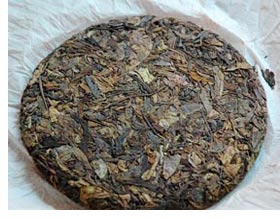
Pu-erh Tea
What is Pu-erh tea
Pu-erh tea is made from the broad leaf variety (camellia sinensis var. assamica) of the tea plant camellia sinensis from the Southwest region of Yunnan China, believed to be the birthplace of tea. Over 1200 years ago, the people of the area began cultivating "tea gardens," open areas, mostly in the high mountains, where tea trees are grown, coexisting with the native plants and ecology. Today these tea gardens continue to be tended and harvested by the aborigines of this region. Not only are we privileged to be able to consume tea from these ancient tea trees, the traditional packaging and processing of the tea have remained essentially unchanged to this date, earning Pu-erh tea the reputation of being the "King of Teas" or the "Historical Tea."
While most teas, by and large, are best consumed soon after production to retain both their flavor and antioxidant value, Pu-erh can be aged and refined like wine. It undergoes a fermentation process where microbes act on the tea leaves over time, causing the leaves to darken and the flavor to change, becoming smoother. Depending on the conditions and environment of aging, the taste can transform through various stages of being fruity, nutty, grassy, herbal and earthy.
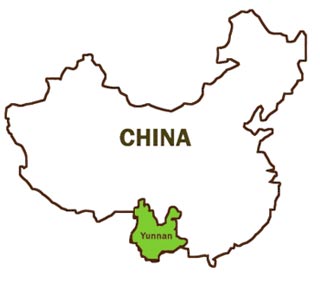 |
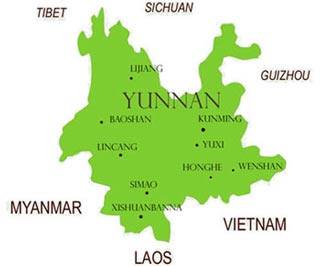 |
|
Pu-erh Tea Types
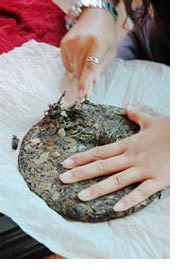
There are two types of Pu-erh: Raw Pu-erh and Cooked (or “Ripe”) Pu-erh.
Often Pu-erh teas are referred to as aged teas. This is because, unlike white tea, green tea, black tea, and most oolong teas, which are highly perishable and have a short shelf life, well-made pu-erh teas may be stored and aged for years of enjoyment. Also, unlike other teas, Pu-erh teas are usually exposed to a fermentation process.
Both types of Pu-erh Tea (Raw and Cooked) are made with Sai qing “sun-cured green tea,” which is processed by withering, roasting, rolling, kneading and drying the leaves in the sun.
This is how Raw Pu-erh is made: After it is processed as Sai Qing, the tea leaves can either be left loose or compressed into shapes. At this point the tea may either be consumed in this “raw” green/semi-green form, or properly stored for aging, (which means the tea will be subject to further oxidation and to fermentation).
This is how Cooked (or “ripened”) Pu-erh Tea is made: It is subjected to a transformation through natural fermentation. After the tealeaves have been processed as Sai qing, they are intentionally fermented in piles by adding purified water and mixing the tealeaves in a well-ventilated, climate and temperature controlled room. This process is similar to composting.
Once the desired fermentation is complete, the tea is sorted, graded, and then processed as either loose pu-erh or it can be compressed into shapes (like tea bricks or tea cakes).
The flavor profile of many pu-erh teas are complex layers of pungent earth, moss, damp wood, with and prevailing sweetness.
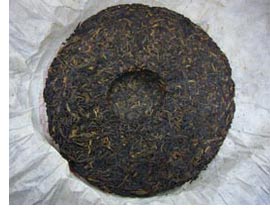
History of Pu-erh Tea
Puer tea has a recorded history of more than 1,700 years. Many people in the area believe the tea plant was left to them by the Prime Minister of Shu, named Zhugeliang, during the Three Kingdoms period (A.C. 220 to 280). Though the area is considered the birthplace of the tea plant, it is unknown exactly when the species was first used.
As the fame of the tea spread through trade and traveling merchants, its popularity increased in neighboring regions as well as distant kingdoms. By the Tang dynasty (A.C. 618 to 907) cultivation and trade of Puer tea was flourishing and tea cakes from the area had already reached the West.
By the end of the Ming dynasty (1368 to 1644) and early part of the Qing dynasty (1644 to 1911) the production and export of Puer tea had reached a historical peak. Cakes and bricks from the Six Famous Tea Mountains of Xishuangbanna and Simao were being transported throughout China, Japan, Tibet, Southeast Asia, and on to the west along common trade routes. Specially shaped tea cakes were sent to the Imperial court as tribute and the Emperor presented smaller sized Puer bricks as reward to his officials.
During the 1700's taxation on Puer tea began to increase. As the taxation increased, it became more and more difficult for the tea farmers and merchants to make a living selling tea and as a result production dropped. By the end of the Qing dynasty Puer production had dwindled to a small fraction of what it had been. A series of disastrous fires destroyed large sections of the Six Famous Tea Mountains and a combination of disease and neglect affected the remaining half. After the fall of the Qing dynasty, some effort was made to improve the plight of tea production in the area, but increased taxation combined with competition from colonial tea producers further diminished Puer export.
After the establishment of the People's Republic of China in 1949, renewed efforts were made to revive Puer tea production by exploring new areas for tea cultivation, opening new factories, and establishing special tea-research institutes. With the Open Policy of 1978 and subsequent economic reforms, there has been a steady increase in Puer production and export. Not only has there been an increase in large scale production and newer scientific Wou Dui style Puer, but also a renewed interest in Vintage Puer and traditional small-crafted Puers as part of a growing world-wide Puer connoisseurship.
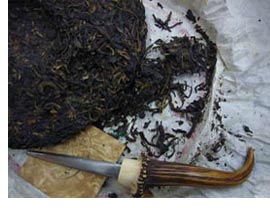
Early Production Method and Trade of Puer Tea
The modes of early Puer production and trade are somewhat shrouded by history, though preserved official documents and local oral traditions give us some insight.
Tea leaves were harvested from tea forest trees found on the Six Famous Tea Mountains of southern Yunnan. The locations of these famous mountains have "shifted" gradually over time in different historical references. Their locations were spread throughout Xishuangbanna and Simao primarily above the Mekong River.
Initially the leaves were processed using ancient Tang dynasty style steamed and pounded brick methods, though by the Ming dynasty production had developed to a method similar to today's production of Sheng style Puers.
After harvest, the leaves went through an initial processing to create Mao Cha, or "rough tea". The leaves were first allowed to wilt slightly, reducing their moisture content and making them pliable. The tea makers then used their bare hands to fire the leaves in a large wok for the "killing green". The fired leaves were gently rolled to break down cell walls without destroying the shape of the leaf, then layed out in the sun to dry.
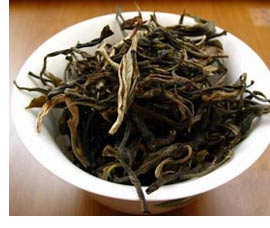
This rough tea was sprinkled with water to moisten the leaves and keep them from breaking as they were packed into bamboo baskets, and carried to a factory in the town of Puer-Simao for final processing and export. It is this collection area in Puer-Simao where the tea from this region eventually acquired its name. The journey was rigorous, often taking one or two weeks. During this time, the tea was exposed to the elements - morning dew, midday sun, and cool mountain air.
At the factory, the leaves were re-hydrated with steam and pressed into a variety of shapes depending on the tea's final destination. Beginning in the Qing dynasty, the standard shape was a stone pressed cake weighing 49 Liang (375 g) which was bound together in stacks of seven using a shingle of young dragon bamboo. For the Dalailamma, the tea was pressed into a flambeau shape. For the Chinese Emperor, tea was molded into a pumpkin like shape called Jingua Gongcha - "Gold Melon Tribute Tea". Special bricks weighing 250 g were also sent to the Emperor to be given as rewards to his officials.
After pressing, the bricks were again moistened with water to prepare them for the long journeys along the Tea Routes from southern Yunnan. One led from Puer up through Yunnan, Sichuan, and into Tibet where it is still used to make traditional Tibetan Butter Tea. Another led to the border with Burma where it separated into three separate routes - one to India (and eventually Europe), one to Thailand, and one to Malaysia. A third route wound through Laos to Vietnam, from where it could be shipped to islands across the South China Sea. Others spread out towards eastern China to be delivered as tribute to the Capital or to coastal ports to be shipped overseas.
Journeys along the Tea Routes were extremely arduous and could take up to a year. Though the tea was drunk fresh at its origin, the cakes that reached their destinations along these routes were already aged and oxidized significantly. For this reason, distant connoisseurs came to associate these aged, mellow, well-traveled flavors and aromas with Puer tea.
Criteria For Choosing Pu-erh Tea
The quality of Pu-erh tea is based on a number of factors: the origin of its raw material, the method of cultivation, the time of the year it is harvested, and the particular conditions under which it is stored.
Good quality Pu-erh tea comes from the four major Pu-erh producing regions in Yunnan, namely, Simao, Xishuangbanna, Boshan, and Lincang. These tea producing regions are situated in the southwestern corner of China, bordering Laos, Myanmar, and Vietnam. Because these regions enjoy a mild, subtropical climate with an abundance of annual rainfall and the soil is rich in minerals with inherently balanced pH values, they are ideal for cultivating Pu-erh tea trees. According to the Pu-erh Yunnan Local Standards, the raw materials used to produce Pu-erh tea must be the broad-leaf species from Yunnan Province. Tea leaves from regions other than Yunnan are not considered true Pu-erh tea.
Pu-erh tea is cultivated in two different ways
1) Plantation bushes: These plants are created from breeding or from cuttings. They are planted densely in relatively low altitudes and always kept small. Most require fertilizers and pesticides. Plantation bushes can yield large quantities of tea, and are thus able to meet the demand of mass production. This is the most common type of Pu-erh tea in today's market.
2) Old-growth trees from ecological arbor tea gardens: These trees were planted through seed selection and grown in higher altitudes. Planted via traditional methods, these trees are grown organically, utilizing resources provided by nature and maintaining the ecological balance. Most of the trees in these tea gardens are hundreds of years old. The old-growth tea trees are limited in their yearly production, but quality of tea harvested from these trees is far superior than that of the small bushes.
Tea is harvested during spring, summer and autumn. New buds break between March and May. After the buds are picked in the early spring, new growth appears every several weeks for the duration of the growing season. The spring harvest, known as the "first flush" or "early spring tea," is the finest crop of the year's production. Leaves harvested in autumn are generally second to the first flush but superior to the summer harvest in quality.
Visual Inspection of Pu-erh Tea
Good quality Pu-erh loose tea or tea cakes (raw or ripe) should contain many tippy buds and strips of whole leaves and not broken leaves. The surface of the tea cake should be smooth, clean and healthy looking. A good quality Pu-erh tea cake should smell fresh and the broth should be translucent (not cloudy), aromatic and absent an odd taste.
Grade:
Pu-erh can be categorized into ten grades, one to ten. The grades are determined by the time of harvest, amount of buds, size of the leaves and freshness of the leaves. The lower the number, the better the overall quality of the leaves. Premium leaves are limited in quantity. Many tea cakes feature a blend of several grades to attain a desired flavor. This blending is usually disclosed by the tea producer. In other cases, there may be less benign reasons for producers to blend several grades of tea together.
Storage condition:
It is suggested that raw Pu-erh tea, particularly good quality raw Pu-erh tea, be stored to allow for slow aging and fermentation. For optimum results, the tea should be stored in conditions where: 1) humidity is dry to moderate; 2) temperature is moderate and maintained within a reasonable range; 3) sunlight is minimized; and 4) there is some, but not excessive, ventilation so that oxygen is provided for the fermentation process.
On the other hand, DO NOT:
- store in an environment where there are other odors as the Pu-erh has a tendency to absorb surrounding odors;
- store in high humidity;
- store in high temperatures;
- store in sunlight for extended periods of time
| Green Tea | Black Tea | White Tea | Yellow Tea | Oolong Tea | Dark Tea | Pu Erh | Scented | Flowering | Herbal | Tea Powder |
| Navigation |
| Home (ViconyTeas) |
| Tea Directory (VTD) |
| Tea Importers |
| Tea Exporters |
| Tea Wholesalers |
| Informative Tea Web |
| Tea Association |
| Tea Encyclopedia |
| Online Tea Shop |
| Tea Dictionary Online |
Copyright©2016 | Pu-erh Tea

